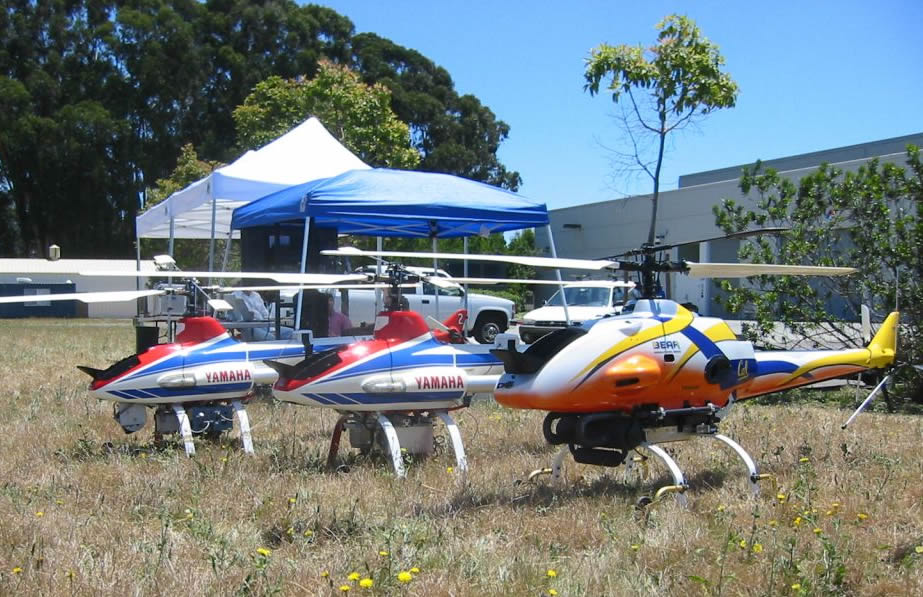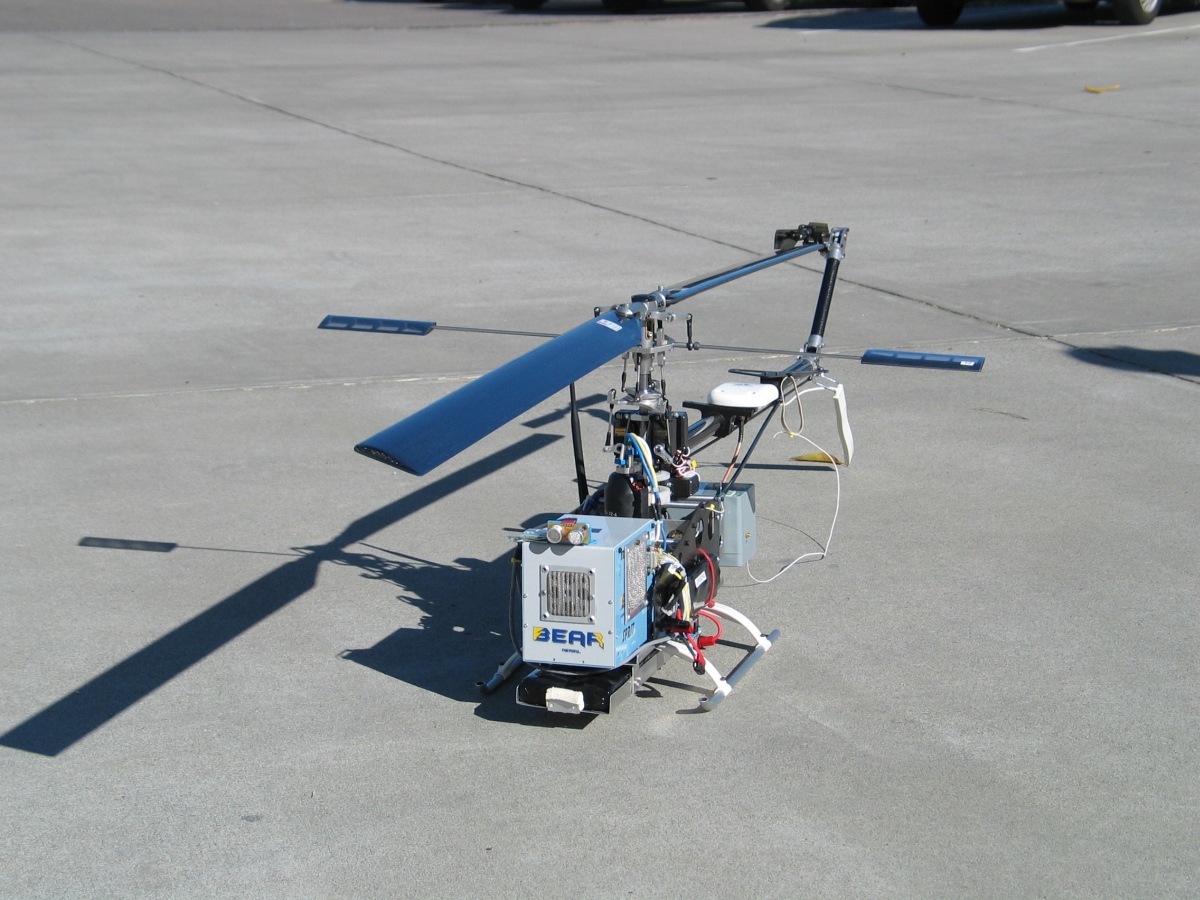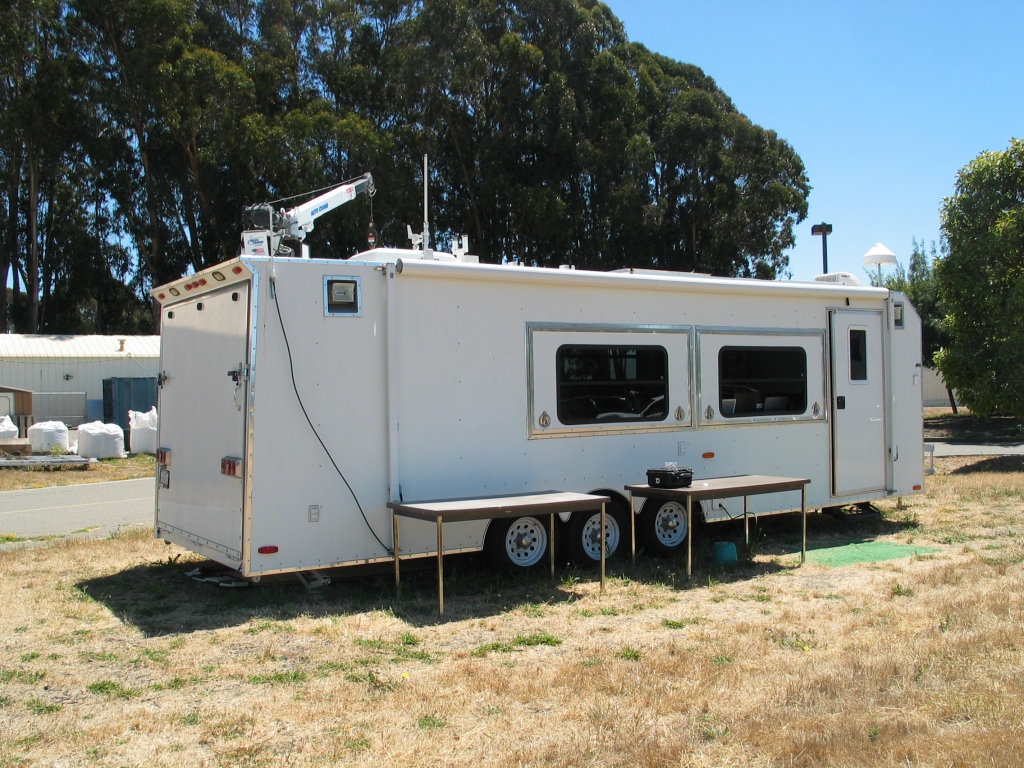Rotorcraft-based Unmanned Aerial Vehicles (RUAVs)
BEAR research group currently operates six fully intrumented helicopter-based UAVs, implemented on various platforms such as Yamaha R-50,
RMAX, Maxi-Joker electric helicopter, and Bergen Industrial Twin. Each of Berkeley UAVs are designed to operate as a part of scalable multi-agent
UAV network as well as fully independent individual UAV agents. Each of BEAR UAV can be operated for preprogrammed waypoint navigation,
interactive waypoint navigation, and in a slave mode, in which the vehicle follows the trajectory received in realtime.
The standardized vehicle command interface and the communication backbone in IEEE802.11 wireless protocol enable the highly scalable operation of BEAR UAVs.
To facilitate the autonomous flight, each UAV is equipped with small-size strapdown inertial navigation system, high-accuracy DGPS, flight computer based on industrial PC-104,
and several other sensors for the specific needs to support various research programs. Laser range finders, firewire cameras, ultraonic sensor arrays are such examples. In the following, a brief comparasion chart for BEAR UAVs' specifications is given.


Ursa Electra series |
Ursa Major series |
Ursa Magna series |
Ursa Maxima series |
|
Base platform |
Maxi-Joker |
Bergen Industrial Twin |
Yamaha R-50 |
Yamaha RMAX |
Length |
2.2m |
2m |
3.58m |
3.63m |
Width |
0.26m |
0.53m |
0.72m |
0.72m |
Height |
0.41m |
0.66m |
1.08m |
1.08m |
Rotor diameter |
1.8m |
1.8m |
3.07m |
3.12m |
Dry weight |
4.5kg |
10kg |
44kg |
58kg |
Payload |
4kg |
7kg |
20kg |
30kg |
Powerplant |
DC Brushless motor (3.0hp) with 10s4p Lithium-Polymer Battery |
Twin Genoa air-cooled two-stroke gasoline engine |
98cc water-cooled single cylinder 2 stroke engine |
256 cc water-cooled two-stroke, horizontally opposed configuration 21 horsepower |
Flight Time |
15min |
20min |
30min |
30min |
Avionics Operation Time |
60min |
60min |
60min |
120min |
CPU |
P3 700MHz |
P3 700MHz |
Primary: AMD K6 400MHz Secondary: AMD K6 400MHz |
Primary: P3 700MHz Secondary: P4 1.6GHz |
Navigation sensors |
Inertial Science ISIS-IMU NovAtel OEM4 L1/L2 |
Systron-Donner DQI-NP NovAtel OEM3 MillenRT2 |
Systron-Donner DQI-NP NovAtel OEM3 MillenRT2 |
Systron-Donner CMIGITS-II NovAtel OEM3 MillenRT2 or Inertial Science ISIS-IMU NovAtel OEM4 L1/L2 |
Additioina Sensors |
Heading sensor Ultrasonic array |
N/A |
Ultrasonic altimeter Laser rangefinder Stereovision Cameras |
3-D laser range finder Heading sensor |
Ursa Maxima series
Ursa Maxima series UAVs are built on the acclaimed Yamaha industrial helicopter series, RMAX, which features a powerful horizontally-opposed two-stroke gasoline engine and more tightly integrated (than its predecessor) onboard electronics. RMAX is also equipped with an onboard DC generator, which can power the custom avionics in addition to the builtin Yamaha electronics. YACS (Yamaha Attitude Control System) offers low level of dynamics stabilization using the onboard accelerometers and rate gyros. Without GPS, the YACS cannot provide a full stabilization of the dynamics, and therefore the light-weight yet powerful avionics designed by experienced engineers in BEAR are mounted under the fuselage are connected to YACS, sending the vehicle control signals to the control surfaces via RS-232. This structure allows a simple and reliable interfacing to the existing system. These are the primary platform of BEAR researches when the long mission time, large payload, and high level of system reliability are required. Originally purchased in December 1999 by BEAR group, these powerful and reliable birds are finally instrumented and automated- now serving as the flagships of BEAR fleet.

Developed by Hoam Chung and David Shim
Ursa Magna series
Ursa Magna series are built on Yamaha's first-generation industrial UAV, R-50, which has a lightly integrated stability augmented system (SAS), YACS, which was a $30,000 option to the baseline model. Similar to The interfacing is done by connecting the custom avionics between the provided by-pass connectors, thus injecting our own control signal in place of the originals. Although not as advanced as its successor, R-50 still offers exceptional level of reliability and unaltered flight characteristics typically found on radio-control helicopters with the Bell-Hiller stabilizer. BEAR group adopted R-50 in the summer of 1999 and successfully automated in the sprint of 2000. The orignial avionics designed and implemented in the summer of 1999 has flown numerous experiment missions such as waypoint navigation, visual landing, and upto the urban navigation in December 2004, demonstrating the versatility, expandability, and reliability of the BEAR avionics.

Left:: Ursa Magna 2, developed in 1999 by David Shim
Right: Ursa Magna 1, developed in 2002 by Hoam Chung and David Shim
Ursa Electra 1
Ursa Electra series is, as the name implies, based on an electrically powered radio-control helicopter, Maxi-Joker. Originally designed to serve as the vehicle platform for Perch-n-Move project from DARPA, the vehicle is capable of fully autonomous takeoff and landing without any external support, unlike the gas-powered siblings do for engine start and so on. Ursa Electra helicopters are powered by the extremely high capacity Lithium-Polymer batteries, the same kind that poweers most of today's cellphones but only much larger, provides the enormous amount of electric charge to enable the vehicle to fly around 20 minutes. (this is longer than the flight tiime of simialr-size gas-powered helicopters with a fuel tank with standard capacity) As can be guessed, the vehicle's operation is quiet, clean, and of much lower maintenance- all it takes to start is just a flick of switch on the transmitter, and voila, the vehicle is in the air. (forget about carrying fuel pumps, gallon jugs, glow heater, and, oh yes, a rag to clean the vehicle from the oily residue) The quiet and straightforward operation of electronic UAV is extremely attractive for a first-hand experiment platform and for multi-agent operation.

Developed by David Shim
Fixed-Wing UAVs: SmartBAT
BEAR group is also expanding its research scope into the advanced control and coordination of fixed-wing UAVs. Leveraging on our expertise, experiences, and thoroughly invesitgated flight control software from the rotary wing cousins, BEAR group will soon be able to demonstrate a fully autonomous UAV platofrm. We choose a wing-body type UAV for its rugged construction and the convenience to hand launch without the need of runway (which we don't have!!).
The wing-body design offers the following advantages:
- -Durable EPP construction: highly resilient to crash
- Throw-launch: manual or automatic launching possible
- Wingspan: 48”, 60”
- Electrically powered (12.4V 2100mAh)
- Max speed: 55mph
- Low-cost, easy to build
- -Light weight (~1kg including payload)
- -Highly maneuverable
- -Sufficient payload for basic navigation system plus lightweight sensors and cameras


click the left picture to watch an introductory video clip on Berkeley SmartBAT (by Travis Pynn)
Ground Station
From a humble start of Ryder's rental trucks and a roll-out cart, BEAR group now enjoys the state-of-the-art ground station, thanks to our collaborator, Perry Kavros. The ground station is equipped with
- Ground Monitoring/Command Station
- DGPS broadcasting system
- Full-duplex VOX system
- High-gain antennae for 802.11 and radio modem
- Onboard generator
- 1-ton Crane
- Audio/Video system with 42" Plasma screen
- Workbench
- Chargine station
- Weather station
- UPS
- 2.4GHz Wireless image link
